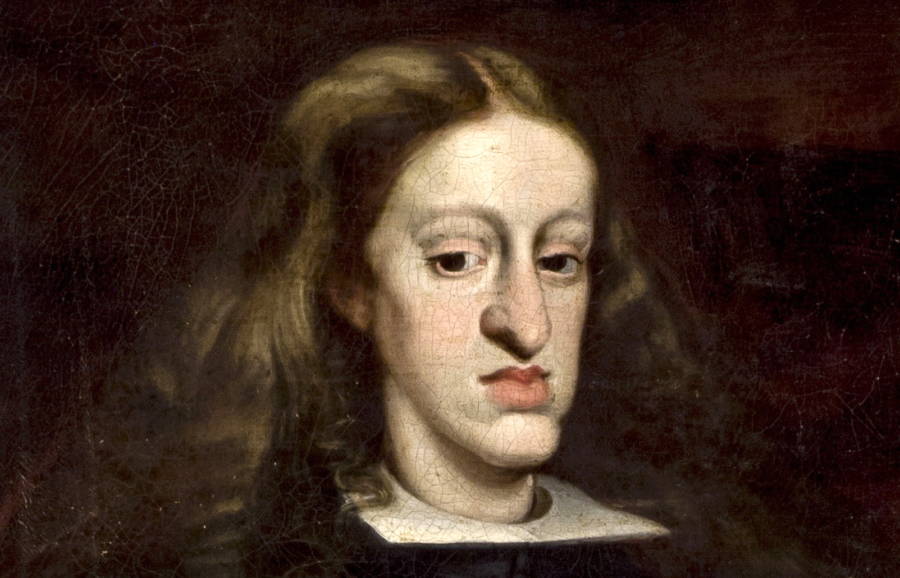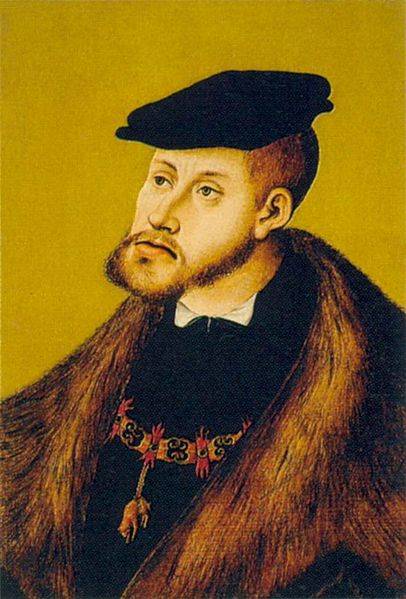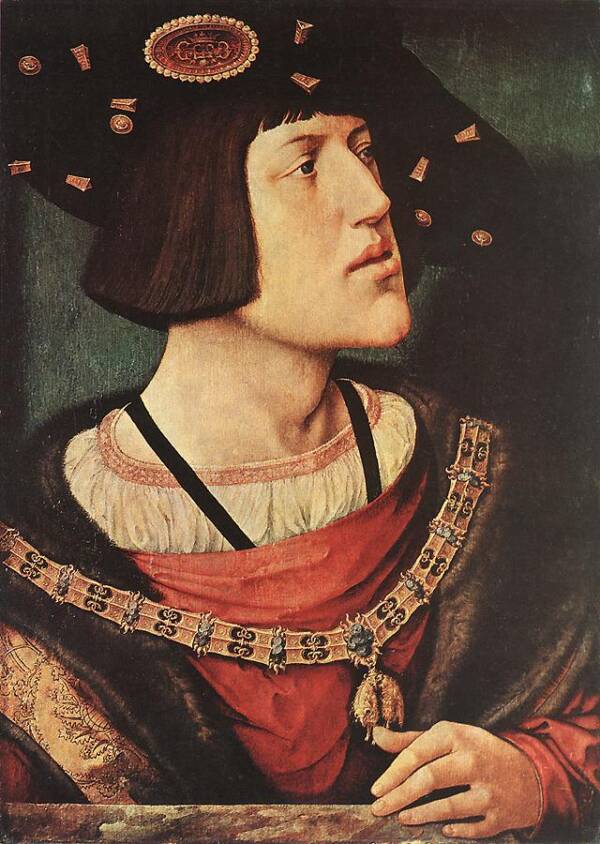Due to two centuries of inbreeding, the Habsburg family was ravaged by extreme physical deformities, including impotence, bowed legs, and the infamous Habsburg jaw.
While marriages between biological relatives were common in the ruling houses of Europe well up until the last century (Queen Elizabeth II actually married her own third cousin), the Spanish Habsburgs engaged in the practice with particularly dangerous abandon. Nine out of the eleven total marriages that occurred among them during the 184 years they ruled Spain from 1516 to 1700 were incestuous.
In fact, modern researchers widely state that generations of inbreeding among the Spanish Habsburgs resulted in the infamous “Habsburg jaw” deformity and ultimately caused their downfall.
Due to incest, the family’s genetic line progressively deteriorated until Charles II, the final male heir, was physically incapable of producing children, thus bringing an end to Habsburg rule.
What Is The Habsburg Jaw?

Wikimedia CommonsThis portrait of Charles II of Spain clearly depicts his Habsburg jaw.
But while the line was intact, this inbreeding caused this royal family to exhibit a number of peculiar physical traits, especially one known as the Habsburg jaw or the Habsburg chin. The most salient indicator of the family’s inbreeding, the Habsburg jaw is what doctors refer to as mandibular prognathism.
This condition is marked by a protrusion of the lower jaw to the point that it’s significantly larger than the upper jaw and creates an underbite sometimes bad enough that it can interfere with your speech and make it difficult to fully close your mouth.
When the first Spanish Habsburg ruler, Charles V, arrived in Spain in 1516, he couldn’t fully close his mouth due to his Habsburg jaw. This reportedly caused one bold peasant to shout at him, “Your majesty, shut your mouth! The flies of this country are very insolent.”
The House Of Habsburg

Wikimedia CommonsArtists did not fail to capture Charles V of Spain’s Habsburg jawline.
Their rule in Spain may have officially begun in 1516, but the Habsburgs, originally of German and Austrian background, had been controlling various regions of Europe since the 13th century. Their Spanish reign was set into motion when Habsburg ruler Philip I of Burgundy (including pieces of present-day Luxembourg, Belgium, France, and the Netherlands) married Joanna of Castile, the female heir to the throne of what’s now much of Spain, in 1496.
After a decade of political wrangling and skirmishes with competitors for power in Spain, Philip I took the throne of Castile in 1506, six years after having fathered Charles V, who himself took the Spanish throne in 1516.
However, just as these Spanish Habsburgs themselves had received the crown through marriage, they knew that it could easily pass out of their hands in the same way. In their determination to keep the Spanish monarchy within the family, they began to look for royal spouses only within their own family.
The Cost Of Generations Of Inbreeding
Besides ensuring that the throne remained in the grip of the Habsburgs, this inbreeding also had unintended consequences that would eventually lead to the dynasty’s downfall. It wasn’t just the crown that was passed down from generation to generation, but a series of genes that produced birth defects.
In addition to being socially and culturally taboo, incestuous marriages are harmful in that they lead to higher rates of miscarriages, stillbirths, and neonatal deaths (only half of the Habsburg children survived to the age of 10, compared with the 80 percent survival rate of children from other Spanish families of the same time period).
Marriage between close family members also increases the chance that harmful recessive genes — which would normally peter out thanks to healthy dominant genes from non-related parents — will continue to be passed down (Queen Victoria of the United Kingdom unwittingly spread recessive hemophilia across the entire continent thanks to the continued inter-marrying of the European royal families).
For the Habsburgs, the most well-known trait that was passed down was the Habsburg jaw.
Royals Affected By The Habsburg Jaw

Wikimedia CommonsMarie Antoinette’s Habsburg jaw was not as pronounced as some of the other royals, but she did have a protruding lower lip.
One of the most famous Habsburgs (not of the Spanish Habsburgs, however) did not entirely manage to dodge the family trait either: Marie Antoinette of France, although famously good-looking, had “a projecting lower lip” that made it seem as though she had a constant pout.
But Marie Antoinette got off easy compared with the last Habsburg ruler of Spain, who took the throne in 1665.
The End Of The Line
Nicknamed El Hechizado (“the hexed one”), Charles II of Spain had a lower jaw so pronounced he struggled to eat and speak.
In addition to his Habsburg jaw, the king was short, weak, impotent, mentally handicapped, suffered numerous intestinal problems, and did not even speak until he was four years old. One French ambassador sent to scope out a prospective marriage wrote back that “The Catholic King is so ugly as to cause fear and he looks ill.”

Wikimedia CommonsPhilip IV of Spain, who passed his Habsburg chin down to his son, Charles II, along with his crown.
Charles II’s father, Philip IV, had married his own sister’s daughter, a dangerously close relationship that made him both Charles’s father and great-uncle. Due to the centuries of consanguineous marriages that led up to the birth of the final heir, modern researchers have found that the inbreeding coefficient (the likelihood that someone will have two identical genes due to their parents level of relation) was almost as high as that of a child born of an incestuous relationship.
Charles II, Habsburg jaw and all, was not able to produce any children of his own; researchers speculate that he may also have been infertile. His body finally gave out and he died in 1700 when he was just 38 years old — the accumulation of two centuries’ worth of harmful traits being passed down to a single body.
They thought keeping power within the family would keep them strong, but it ultimately made them weak. The Habsburgs lost the throne in Spain thanks to the very process that they had hoped would preserve it.
Modern Research On The Habsburg Jaw

Wikimedia CommonsHoly Roman Emperor Charles V, a 16th-century leader of the House of Habsburg and a notorious example of the Habsburg chin.
While both inbreeding and the Habsburg jaw have always been associated with the House of Habsburg, there had never been a scientific study that had conclusively linked incest with the family’s notorious facial feature. But in December 2019, researchers published the first paper demonstrating that incest indeed caused this notorious deformity.
According to lead researcher Professor Roman Vilas from the University of Santiago de Compostela:
“The Habsburg dynasty was one of the most influential in Europe, but became renowned for inbreeding, which was its eventual downfall. We show for the first time that there is a clear positive relationship between inbreeding and appearance of the Habsburg jaw.”
Vilas and company made their determinations by having facial surgeons examine dozens of portraits of Habsburgs to evaluate their degree of jaw deformity and then analyzing the family tree and its genetics to see if a higher degree of relatedness/inbreeding among certain family members made for a greater amount of deformity in those people. Sure enough, that is precisely what the researchers found (with Charles II unsurprisingly singled out as having one of the greatest degrees of deformity and relatedness).
And the findings may not stop there. In addition to the Habsburg jaw, researchers may have plenty more to study regarding this family and its unusual genetic makeup.
“The Habsburg dynasty serves as a kind of human laboratory for researchers to do so,” said Vilas, “because the range of inbreeding is so high.”
After this look at the Habsburg jaw, discover more about Spain’s Charles II. Then, read up on some of history’s most famous cases of incest.





